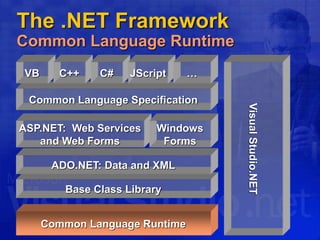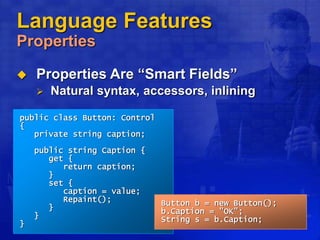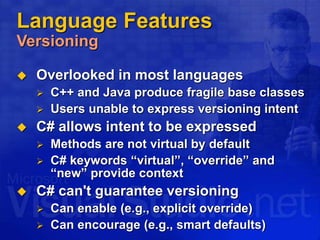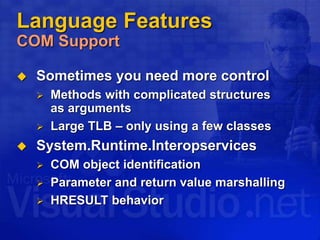Introduction to c_sharp
- 2. Introduction to C# Raimonds Rudmanis Senior Consultant Microsoft Baltic
- 3. Session Prerequisites This session assumes that you understand the fundamentals of Object oriented programming This is a Level 200 Session
- 4. What Will Be Covered Today Brief introduction to the .NET framework C# language overview
- 5. Agenda Hello World The .NET Framework Design Goals of C# Language Features
- 6. Hello World DEMO 1: Hello World using System; class Hello { static void Main() { Console.WriteLine("Hello world"); } }
- 7. Agenda Hello World The .NET Framework Design Goals of C# Language Features
- 8. The .NET Framework Overview Base Class Library Common Language Specification Common Language Runtime ADO.NET: Data and XML VB C++ C# VisualStudio.NET ASP.NET: Web Services And Web Forms JScript … Windows forms
- 9. The .NET Framework Common Language Runtime Base Class Library Common Language Specification Common Language Runtime ADO.NET: Data and XML VB C++ C# VisualStudio.NET ASP.NET: Web Services and Web Forms JScript … Windows Forms
- 10. New Runtime Environment – Common Language Runtime Language Interoperability Common Classes for all Languages Common Types for all Languages Runtime Controls Compilation to Machine Code Assemblies Application Domains The .NET Framework Common Language Runtime
- 11. The .NET Framework Common Language Runtime Simplified development XCOPY deployment Scalability Rich Web clients and safe Web hosting Potentially multi-platform Multiple languages (cross inheritance) Increases productivity Robust and secure execution environment
- 12. .NET Framework and CLR CLR Execution Model VBSource code Compiler C++C# CompilerCompiler Assembly IL Code Assembly IL Code Assembly IL Code Operating System Services Common Language Runtime JIT Compiler Native Code Managed code Unmanaged Component
- 13. The .NET Framework .NET Framework Services Base Class Library Common Language Specification Common Language Runtime ADO.NET: Data and XML VB C++ C# VisualStudio.NET ASP.NET: Web Services and Web Forms JScript … Windows Forms
- 14. The .NET Framework .NET Framework Services ASP.NET Separation of code and presentation Compiled Web Forms Web Services Windows® Forms Framework for building rich clients ADO.NET, Evolution of ADO New objects (e.g., DataSets) XML support throughout
- 15. Agenda Hello World The .NET Framework Design Goals of C# Language Features
- 16. Design Goals of C# The Big Ideas The first “Component Oriented” language in the C/C++ family Everything really is an object Next generation robust and durable software Preserving your investment
- 17. Design Goals of C# A Component Oriented Language C# is the first “Component Oriented” language in the C/C++ family Component concepts are first class Properties, methods, events Design-time and run-time attributes Integrated documentation using XML Enables one-stop programming No external files like header files, IDL, etc. Can be embedded in ASP pages
- 18. Design Goals of C# Everything Really Is an Object Traditional views C++, Java™: Primitive types are “magic” and do not interoperate with objects Smalltalk, Lisp: Primitive types are objects, but at great performance cost C# unifies with no performance cost Deep simplicity throughout system Improved extensibility and reusability New primitive types: Decimal, SQL… Collections, etc., work for all types
- 19. Design Goals of C# Robust and Durable Software Garbage collection No memory leaks and stray pointers Exceptions Error handling is not an afterthought Type-safety No uninitialized variables, unsafe casts Versioning Pervasive versioning considerations in all aspects of language design
- 20. Design Goals of C# Preserving Your Investment C++ Heritage Namespaces, enums, pointers (in unsafe code), unsigned types, etc. No unnecessary sacrifices Real-world useful constructs foreach, using, switch on string decimal type for financial applications ref and out parameters Millions of lines of C# code in .NET Short learning curve Increased productivity
- 21. Design Goals of C# Interoperability C# VB.NET MC++ JScript ... .NET Languages COM OLE Automation XML/SOAP Dynamic Link Libraries P/Invoke and unsafe code
- 22. Agenda Hello World The .NET Framework Design Goals of C# Language Features
- 23. Language Features Program Structure Namespaces Contain types and other namespaces Type declarations Classes, structs, interfaces, enums, and delegates Members Constants, fields, methods, properties, indexers, events, operators, constructors, destructors Organization No header files, code written “in-line” No declaration order dependence
- 24. Language Features Program Structure using System; namespace System.Collections { public class Stack { Entry top; public void Push(object data) { top = new Entry(top, data); } public object Pop() { if (top == null) throw new InvalidOperationException(); object result = top.data; top = top.next; return result; } } }
- 25. Language Features Type System Value types Directly contain data Cannot be null Reference types Contain references to objects May be null int i = 123; string s = "Hello world"; 123i s "Hello world"
- 26. Language Features Type System Value types Primitives int i; Enums enum State { Off, On } Structs struct Point { int x, y; } Reference types Classes class Foo: Bar, IFoo {...} Interfaces interface IFoo: IBar {...} Arrays string[] a = new string[10]; Delegates delegate void Empty();
- 27. Language Features Predefined Types C# predefined types Reference object, string Signed sbyte, short, int, long Unsigned byte, ushort, uint, ulong Character char Floating-point float, double, decimal Logical bool Predefined types are simply aliases for system-provided types For example, int = System.Int32
- 28. Language Features Classes Single inheritance Multiple interface implementation Class members Constants, fields, methods, properties, indexers, events, operators, constructors, destructors Static and instance members Nested types Member access Public, protected, internal, private
- 29. Language Features Structs Like classes, except Stored in-line, not heap allocated Assignment copies data, not reference No inheritance Ideal for light weight objects Complex, point, rectangle, color int, float, double, etc., are all structs Benefits No heap allocation, less GC pressure More efficient use of memory
- 30. Language Features Classes and Structs struct SPoint { int x, y; ... } class CPoint { int x, y; ... } SPoint sp = new SPoint(10, 20); CPoint cp = new CPoint(10, 20); 10 20 sp cp 10 20 CPoint
- 31. Language Features Interfaces Multiple inheritance Can contain methods, properties, indexers and events Private interface implementations interface IDataBound { void Bind(IDataBinder binder); } class EditBox: Control, IDataBound { void IDataBound.Bind(IDataBinder binder) {...} }
- 32. Language Features Enums Strongly typed No implicit conversions to/from int Operators: +, -, ++, --, &, |, ^, ~ Can specify underlying type Byte, short, int, long enum Color: byte { Red = 1, Green = 2, Blue = 4, Black = 0, White = Red | Green | Blue, }
- 33. Language Features Delegates Object oriented function pointers Multiple receivers Each delegate has an invocation list Thread-safe + and - operations Foundation for framework events delegate void MouseEvent(int x, int y); delegate double Func(double x); Func func = new Func(Math.Sin); double x = func(1.0);
- 34. Language Features Unified Type System Everything is an object All types ultimately inherit from object Any piece of data can be stored, transported, and manipulated with no extra work Stream MemoryStream FileStream Hashtable doubleint object
- 35. Language Features Unified Type System Boxing Allocates box, copies value into it Unboxing Checks type of box, copies value out int i = 123; object o = i; int j = (int)o; 123i o 123 System.Int32 123j
- 36. Language Features Unified Type System Benefits Eliminates “wrapper classes” Collection classes work with all types Replaces OLE Automation's Variant Lots of examples in .NET framework string s = string.Format( "Your total was {0} on {1}", total, date); ArrayList al = new ArrayList(); al.Add( new Customer() ); al.Add( 1 ); al.Add( "test" );
- 37. Language Features Component Development What defines a component? Properties, methods, events Integrated help and documentation Design-time information C# has first class support Not naming patterns, adapters, etc. Not external files Components are easy to build and to consume
- 38. Language Features Properties Properties Are “Smart Fields” Natural syntax, accessors, inlining public class Button: Control { private string caption; public string Caption { get { return caption; } set { caption = value; Repaint(); } } } Button b = new Button(); b.Caption = "OK"; String s = b.Caption;
- 39. Language Features Indexers Indexers are “smart arrays” Can be overloaded public class ListBox: Control { private string[] items; public string this[int index] { get { return items[index]; } set { items[index] = value; Repaint(); } } } ListBox listBox = new ListBox(); listBox[0] = "hello"; Console.WriteLine(listBox[0]);
- 40. Language Features Creating and Firing an Event Define the Event signature Define the Event and firing logic public delegate void EventHandler(object sender, EventArgs e); public class Button { public event EventHandler Click; protected void OnClick(EventArgs e) { if (Click != null) Click(this, e); } }
- 41. Language Features Handling an Event Define and register Event Handler public class MyForm: Form { Button okButton; public MyForm() { okButton = new Button(...); okButton.Caption = "OK"; okButton.Click += new EventHandler(OkButtonClick); } void OkButtonClick(object sender, EventArgs e) { ShowMessage("You pressed the OK button"); } }
- 42. Language Features DEMO 2: Creating an Event Handler Define an Event Handler for a button in a Windows Forms application
- 43. Language Features Attributes Associate information with types and members Documentation URL for a class Transaction context for a method XML persistence mapping Traditional solutions Add keywords or pragmas to language Use external files, e.g., .IDL, .DEF C# solution: Attributes
- 44. Language Features Attributes public class OrderProcessor { [WebMethod] public void SubmitOrder(PurchaseOrder order) {...} } [XmlRoot("Order", Namespace="urn:acme.b2b-schema.v1")] public class PurchaseOrder { [XmlElement("shipTo")] public Address ShipTo; [XmlElement("billTo")] public Address BillTo; [XmlElement("comment")] public string Comment; [XmlElement("items")] public Item[] Items; [XmlAttribute("date")] public DateTime OrderDate; } public class Address {...} public class Item {...}
- 45. Language Features Attributes Attributes can be Attached to types and members Examined at run-time using reflection Completely extensible Simply a class that inherits from System.Attribute Type-safe Arguments checked at compile-time Extensive use in .NET framework XML, Web Services, security, serialization, component model, COM and P/Invoke interop, code configuration…
- 46. What Is A Web Service? HTML = user-to-machine XML/SOAP = machine-to-machine Leveraging the Web Same infrastructure Same programming model Anyone can play Truly scalable distributed applications Stateless and loosely coupled Both Internet and intranet
- 47. Discovery Let’s talk (SOAP) How Does It Work? http://myservice.com HTML or XML with link to WSDL How do we talk? (WSDL) http://myservice.com?wsdl XML with service descriptions http://myservice.com/svc1 XML/SOAP BODY Web Service Web Service Consumer UDDI Find a Service http://www.uddi.org Link to DISCO or WSDL document
- 48. Web Services With .NET Programs Objects Classes Methods Calls Web XML XSD WSDL SOAP Data Schema Services Invocation Application Concepts The .NET framework provides a bi-directional mapping
- 49. Web Services With .NET public class OrderProcessor { public void SubmitOrder(PurchaseOrder order) {...} } public class PurchaseOrder { public string ShipTo; public string BillTo; public string Comment; public Item[] Items; public DateTime OrderDate; } public class OrderProcessor { [WebMethod] public void SubmitOrder(PurchaseOrder order) {...} } [XmlRoot("Order", Namespace="urn:acme.b2b-schema.v1")] public class PurchaseOrder { [XmlElement("shipTo")] public string ShipTo; [XmlElement("billTo")] public string BillTo; [XmlElement("comment")] public string Comment; [XmlElement("items")] public Item[] Items; [XmlAttribute("date")] public DateTime OrderDate; } PurchaseOrder po = new PurchaseOrder(); po.ShipTo = “Anders Hejlsberg"; po.BillTo = “Bill Gates"; po.OrderDate = DateTime.Today; … OrderProcessor.SubmitOrder(po); <?xml version="1.0" encoding="utf-8"?> <soap:Envelope> <soap:Body> <SubmitOrder> <Order date=“20010703"> <shipTo>Anders Hejlsberg</shipTo> <billTo>Bill Gates</billTo> <comment>Overnight delivery</comment> <items> <productId>17748933</productId> <description>Dom Perignon</description> </items> </Order> </SubmitOrder> </soap:Body> </soap:Envelope>
- 50. Language Features DEMO 3: Attributes Create a Web service by using the [WebMethod] attribute
- 51. Language Features XML Comments class XmlElement { /// <summary> /// Returns the attribute with the given name and /// namespace</summary> /// <param name="name"> /// The name of the attribute</param> /// <param name="ns"> /// The namespace of the attribute, or null if /// the attribute has no namespace</param> /// <return> /// The attribute value, or null if the attribute /// does not exist</return> /// <seealso cref="GetAttr(string)"/> /// public string GetAttr(string name, string ns) { ... } }
- 52. Language Features DEMO 4: XML Comments Show how the compiler can auto generate documentation from the source code using XML comments
- 53. Language Features Statements and Expressions High C++ fidelity if, while, do require bool condition Switch statement No fall-through, “goto case” or “goto default” Goto can’t jump into blocks Foreach statement Checked and unchecked statements Expression statements must do work void Foo() { i == 1; // error i + j; // error } switch( arg ) { case 0: case 1: Console.WriteLine(“Low”); case 2: Console.WriteLine(“Med”); break; default: Console.WriteLine(“High”); } switch( arg ) { case 0: case 1: Console.WriteLine(“Low”); break; case 2: Console.WriteLine(“Med”); break; default: Console.WriteLine(“High”); } switch( arg ) { case 0: case 1: Console.WriteLine(“Low”); goto case 2; case 2: Console.WriteLine(“Med”); break; default: Console.WriteLine(“High”); } int i; if ( i ) // error if ( i>0 ) FileClass file; if ( file = OpenFile() ) // error if ( (file = OpenFile()) != NULL ) foreach ( string word in myArray.words ) { Console.WriteLine(“{0}”, word) } static short x = 32767; // Max short static short y = 32767; try { z = checked((short)(x + y)); } catch (OverflowException e) { Console.WriteLine(e.ToString()); } goto in_label; while ( i<100 ) { in_label: i++; } while ( i<100 ) { if ( j>50 ) goto out_label; } out_label:
- 54. Language Features For Each Statement Iteration of arrays Iteration of user-defined collections foreach (Customer c in customers.OrderBy("name")) { if (c.Orders.Count != 0) { ... } } public static void Main(string[] args) { foreach (string s in args) Console.WriteLine(s); }
- 55. Language Features Parameter Arrays Can write “printf” style methods Type-safe, unlike C++ void printf(string fmt, params object[] args) { foreach (object x in args) { ... } } printf("%s %i %i", str, int1, int2); object[] args = new object[3]; args[0] = str; args[1] = int1; Args[2] = int2; printf("%s %i %i", args);
- 56. Language Features Operator Overloading First class user-defined data types Used in base class library Decimal, DateTime, TimeSpan Used in the framework Unit, point, rectangle Used in SQL integration SQLString, SQLInt16, SQLInt32, SQLInt64, SQLBool, SQLMoney, SQLNumeric, SQLFloat…
- 57. Language Features Operator Overloading public struct DBInt { public static readonly DBInt Null = new DBInt(); private int value; private bool defined; public bool IsNull { get { return !defined; } } public static DBInt operator +(DBInt x, DBInt y) {...} public static implicit operator DBInt(int x) {...} public static explicit operator int(DBInt x) {...} } DBInt x = 123; DBInt y = DBInt.Null; DBInt z = x + y;
- 58. Language Features Versioning Overlooked in most languages C++ and Java produce fragile base classes Users unable to express versioning intent C# allows intent to be expressed Methods are not virtual by default C# keywords “virtual”, “override” and “new” provide context C# can't guarantee versioning Can enable (e.g., explicit override) Can encourage (e.g., smart defaults)
- 59. class Derived: Base // version 1 { public virtual void Foo() { Console.WriteLine("Derived.Foo"); } } class Derived: Base // version 2a { new public virtual void Foo() { Console.WriteLine("Derived.Foo"); } } class Derived: Base // version 2b { public override void Foo() { base.Foo(); Console.WriteLine("Derived.Foo"); } } class Base // version 1 { } class Base // version 2 { public virtual void Foo() { Console.WriteLine("Base.Foo"); } } Language Features Versioning
- 60. Language Features Conditional Compilation #define, #undef #if, #elif, #else, #endif Simple boolean logic Conditional methods public class Debug { [Conditional("Debug")] public static void Assert(bool cond, String s) { if (!cond) { throw new AssertionException(s); } } }
- 61. Language Features Unsafe Code COM integration, P/invoke cover most cases Unsafe code Low-level code without leaving the box Enables unsafe casts, pointer arithmetic Declarative pinning Fixed statement Basically “inline C” unsafe void Foo() { char* buf = stackalloc char[256]; for (char* p = buf; p < buf + 256; p++) *p = 0; ... }
- 62. Language Features Unsafe Code class FileStream: Stream { int handle; public unsafe int Read(byte[] buffer, int index, int count) { int n = 0; fixed (byte* p = buffer) { ReadFile(handle, p + index, count, &n, null); } return n; } [dllimport("kernel32", SetLastError=true)] static extern unsafe bool ReadFile(int hFile, void* lpBuffer, int nBytesToRead, int* nBytesRead, Overlapped* lpOverlapped); }
- 63. Language Features COM Support .Net framework provides great COM support TLBIMP imports existing COM classes TLBEXP exports .NET types Most users will have a seamless experience
- 64. Language Features COM Support Sometimes you need more control Methods with complicated structures as arguments Large TLB – only using a few classes System.Runtime.Interopservices COM object identification Parameter and return value marshalling HRESULT behavior
- 65. Language Features DEMO 5: COM and C# Call a COM component from C#
- 66. Language Features DEMO 6: Visual Studio .NET Windows programming with C#
- 67. C# And CLI Standardization Work begun in September 2000 Submitted to ECMA (www.ecma.ch) Active involvement by Intel, HP, IBM, Fujitsu, Plum Hall, … Since December 2001 “C# Language Specification” “Common Language Infrastructure (CLI)”
- 68. C# Books
- 69. C# Customers
- 70. More Resources http://msdn.microsoft.com/ C# language specification C# newsgroups microsoft.public.dotnet.languages.csharp
- 71. Questions?
- 72. © 2001 Microsoft Corporation. All rights reserved.


























![Language Features
Type System
Value types
Primitives int i;
Enums enum State { Off, On }
Structs struct Point { int x, y; }
Reference types
Classes class Foo: Bar, IFoo {...}
Interfaces interface IFoo: IBar {...}
Arrays string[] a = new string[10];
Delegates delegate void Empty();](https://image.slidesharecdn.com/introductiontocsharp-201109215855/85/Introduction-to-c_sharp-26-320.jpg)












![Language Features
Indexers
Indexers are “smart arrays”
Can be overloaded
public class ListBox: Control
{
private string[] items;
public string this[int
index] {
get {
return items[index];
}
set {
items[index] = value;
Repaint();
}
}
}
ListBox listBox = new
ListBox();
listBox[0] = "hello";
Console.WriteLine(listBox[0]);](https://image.slidesharecdn.com/introductiontocsharp-201109215855/85/Introduction-to-c_sharp-39-320.jpg)




![Language Features
Attributes
public class OrderProcessor
{
[WebMethod]
public void SubmitOrder(PurchaseOrder order) {...}
}
[XmlRoot("Order", Namespace="urn:acme.b2b-schema.v1")]
public class PurchaseOrder
{
[XmlElement("shipTo")] public Address ShipTo;
[XmlElement("billTo")] public Address BillTo;
[XmlElement("comment")] public string Comment;
[XmlElement("items")] public Item[] Items;
[XmlAttribute("date")] public DateTime OrderDate;
}
public class Address {...}
public class Item {...}](https://image.slidesharecdn.com/introductiontocsharp-201109215855/85/Introduction-to-c_sharp-44-320.jpg)




![Web Services With .NET
public class OrderProcessor
{
public void SubmitOrder(PurchaseOrder order) {...}
}
public class PurchaseOrder
{
public string ShipTo;
public string BillTo;
public string Comment;
public Item[] Items;
public DateTime OrderDate;
}
public class OrderProcessor
{
[WebMethod]
public void SubmitOrder(PurchaseOrder order) {...}
}
[XmlRoot("Order", Namespace="urn:acme.b2b-schema.v1")]
public class PurchaseOrder
{
[XmlElement("shipTo")] public string ShipTo;
[XmlElement("billTo")] public string BillTo;
[XmlElement("comment")] public string Comment;
[XmlElement("items")] public Item[] Items;
[XmlAttribute("date")] public DateTime OrderDate;
}
PurchaseOrder po = new PurchaseOrder();
po.ShipTo = “Anders Hejlsberg";
po.BillTo = “Bill Gates";
po.OrderDate = DateTime.Today;
…
OrderProcessor.SubmitOrder(po);
<?xml version="1.0" encoding="utf-8"?>
<soap:Envelope>
<soap:Body>
<SubmitOrder>
<Order date=“20010703">
<shipTo>Anders Hejlsberg</shipTo>
<billTo>Bill Gates</billTo>
<comment>Overnight delivery</comment>
<items>
<productId>17748933</productId>
<description>Dom Perignon</description>
</items>
</Order>
</SubmitOrder>
</soap:Body>
</soap:Envelope>](https://image.slidesharecdn.com/introductiontocsharp-201109215855/85/Introduction-to-c_sharp-49-320.jpg)
![Language Features
DEMO 3: Attributes
Create a Web service by using the
[WebMethod] attribute](https://image.slidesharecdn.com/introductiontocsharp-201109215855/85/Introduction-to-c_sharp-50-320.jpg)



![Language Features
For Each Statement
Iteration of arrays
Iteration of user-defined collections
foreach (Customer c in customers.OrderBy("name")) {
if (c.Orders.Count != 0) {
...
}
}
public static void Main(string[] args) {
foreach (string s in args) Console.WriteLine(s);
}](https://image.slidesharecdn.com/introductiontocsharp-201109215855/85/Introduction-to-c_sharp-54-320.jpg)
![Language Features
Parameter Arrays
Can write “printf” style methods
Type-safe, unlike C++
void printf(string fmt, params object[] args) {
foreach (object x in args) {
...
}
}
printf("%s %i %i", str, int1, int2);
object[] args = new object[3];
args[0] = str;
args[1] = int1;
Args[2] = int2;
printf("%s %i %i", args);](https://image.slidesharecdn.com/introductiontocsharp-201109215855/85/Introduction-to-c_sharp-55-320.jpg)




![Language Features
Conditional Compilation
#define, #undef
#if, #elif, #else, #endif
Simple boolean logic
Conditional methods
public class Debug
{
[Conditional("Debug")]
public static void Assert(bool cond, String s) {
if (!cond) {
throw new AssertionException(s);
}
}
}](https://image.slidesharecdn.com/introductiontocsharp-201109215855/85/Introduction-to-c_sharp-60-320.jpg)
![Language Features
Unsafe Code
COM integration, P/invoke cover most cases
Unsafe code
Low-level code without leaving the box
Enables unsafe casts, pointer arithmetic
Declarative pinning
Fixed statement
Basically “inline C”
unsafe void Foo() {
char* buf = stackalloc char[256];
for (char* p = buf; p < buf + 256; p++) *p = 0;
...
}](https://image.slidesharecdn.com/introductiontocsharp-201109215855/85/Introduction-to-c_sharp-61-320.jpg)
![Language Features
Unsafe Code
class FileStream: Stream
{
int handle;
public unsafe int Read(byte[] buffer, int index, int
count) {
int n = 0;
fixed (byte* p = buffer) {
ReadFile(handle, p + index, count, &n, null);
}
return n;
}
[dllimport("kernel32", SetLastError=true)]
static extern unsafe bool ReadFile(int hFile,
void* lpBuffer, int nBytesToRead,
int* nBytesRead, Overlapped* lpOverlapped);
}](https://image.slidesharecdn.com/introductiontocsharp-201109215855/85/Introduction-to-c_sharp-62-320.jpg)









